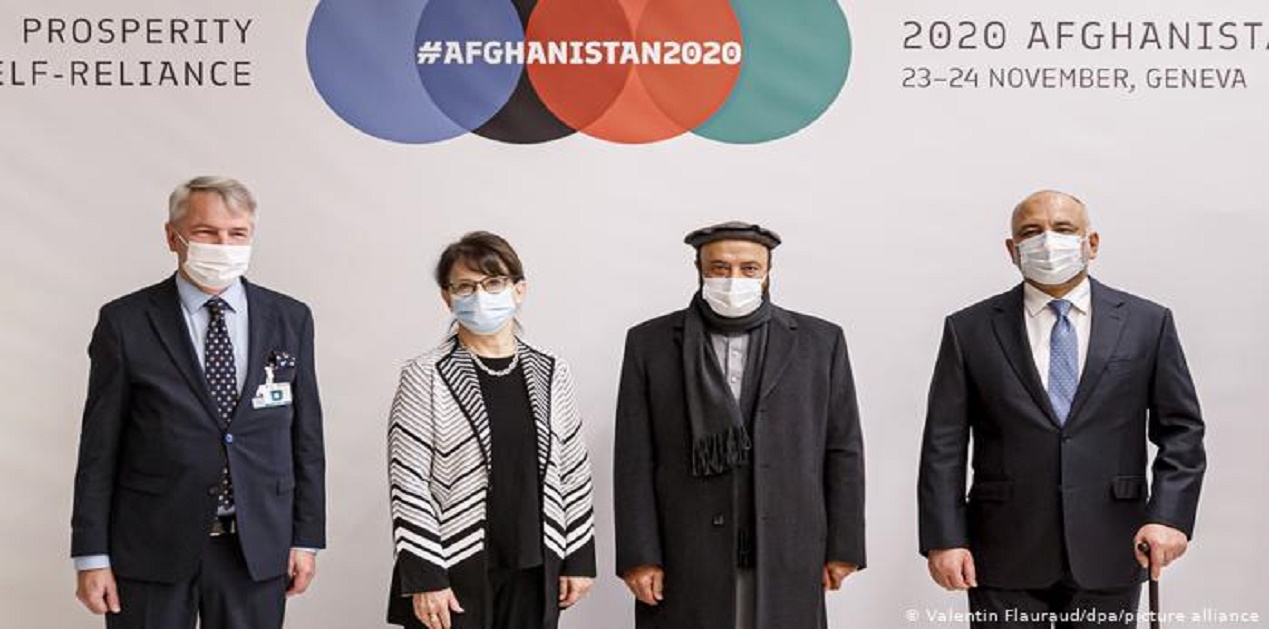With stalled peace talks in Doha and raging violence in the country, Afghanistan is yet again at an inflection point. The critical question is: whether the Afghans and the international community will be able to find a sustainable and peaceful solution to the conflict that has been raging for over 40 years? Or would the streets of Kabul once again experience the same bloodshed that has already consumed an entire generation? A missed opportunity for peace would push the country towards another generational conflict. In this background, over 100 countries and international organizations gathered for a two-day conference in Geneva to renew their commitments towards Afghanistan for the next four years.1
On November 23-24, the Governments of Afghanistan and Finland co-hosted the quadrennial donor meeting in Geneva with its theme ‘Peace, Prosperity and self-reliance’ with the support of the United Nations. Although Afghan-led and –owned ‘Transformation decade’ (2015-2024) that aims to lead Afghanistan towards self-reliance is heading towards its final phase, international aid still finances over 50 percent of the country’s national budget. In previous two donor’s conferences- in Tokyo in 2012, and Brussels in 2016- the international community pledged over USD 16 billion and over USD 15 billion in aid, respectively.2 Comparatively, in 2020, the donor countries promised a reduced amount of USD 12 billion over the next four years with stringent conditions attached, including noticeable progress towards the peace deal.3
Increased violence in Afghanistan
One of the primary reasons that the global community has opted for the lower aid for the 2020-2024 period is the rising concerns about corruption, uncertainty about the peace process, and fragile security scenario. On the last day of the donor’s conference in Geneva, Afghanistan has seen the deadliest twin bombing in Bamiyan province that killed at least 14 people and injured more than 45. Mostly inhabited by the Shiite Hazaras, Bamiyan has been comparatively less violence-prone due to its distant location in the high mountains of Hindu Kush in central highlands of Afghanistan.4 The Taliban denied carrying out the attack; however, the Shiite Hazaras, a religious and ethnic minority, has been repeatedly targeted by terrorist groups like the Islamic State in the country. According to analysts, by not claiming responsibility for the attacks, the Taliban is able “to exert pressure while maintaining deniability for the violence.”5
The international community had hoped that the intra-Afghan talks would provide a rare opportunity for establishing peace in Afghanistan. However, the 29 February US-Taliban withdrawal agreement that laid the foundation of intra-Afghan talks created an asymmetrical power relationship between the Afghan government and the insurgent group. Analysts have often criticized the US-Taliban agreement as “the fig leaf for American military withdrawal”.6 Any chance of building sustainable peace was lost when the US granted the Taliban undeserved legitimacy and thereby making the Afghan government weak.
The high level of violence prevalent in Afghanistan indicates the hastiness of the US policy while dealing with the Taliban. October 2020 has been particularly gruesome for Afghanistan as the Taliban increased the lethality with its targeted killings and suicide bombings. In October 2020, the whole country was shaken by the gruesome attack on Kabul University which killed 22 people and injured 27 more. According to UNAMA, from 1 January to 30 September 2020, there have been 5,939 civilian casualties including 2,117 killed and 3,822 injured in Afghanistan.7 In its quarterly report to the US Congress released on October 30, Special Inspector General for Afghanistan Reconstruction (SIGAR) indicated 50 percent spurt in violence in three months from July to September 2020 as compared to the previous quarter.8
Stalled Peace Process and Trump’s Withdrawal Plan
The historic peace process that began in Doha in September 2020 has not seen any progress. The peace talks are stuck on two questions: the use of Hanafi jurisprudence and whether the February 29 U.S.-Taliban deal could be the basis of intra-Afghan negotiations? The Taliban negotiators have ensured that prioritizing Hanafi jurisprudence will not cause discrimination against the Shias who follow the Jafari School of Islamic jurisprudence. After the removal of the Taliban regime in 2001, Afghanistan has worked towards achieving constitutional and legal parity between Shias and Sunnis in the country. At present, the Shia Personal Status Law allows the previously marginalized religious group to follow their laws.9 However, the Taliban’s rigidity to give paramount status to Hanafi School of jurisprudence threatens the communal harmony in Afghanistan.
Another point of contention between the two negotiating parties is the Taliban’s insistence on accepting the 29th February agreement as the basis for any future negotiations. However, complying with the Taliban’s claim would mean compromising on the demand of ceasefire. The withdrawal agreement gives primacy to negotiations over the ceasefire. It views ceasefire as an outcome of the protracted negotiations rather than a condition for the talks. Given the ongoing stalemate for over two and a half months, US Secretary of State Mike Pompeo recently travelled to Doha to push for a breakthrough. While meeting the negotiating teams on both sides, Mr. Pompeo emphasized the need to expedite the peace talks as the US prepares to bring down its troops from 4,500 to 2,500 by mid-January.10 The surge in the Taliban offensives across the country indicates that the insurgent group does not believe in the spirit of peace talks. If allowed, the Taliban would prefer to establish its control in Afghanistan through military means.
The US troop withdrawal by mid-January would unravel the already fragile security scenario in Afghanistan at a rapid pace. The Taliban considers the presence of the US security forces in the country as a significant obstacle to capture power by force. By withdrawing prematurely, the US is sending a wrong signal to the insurgent group that they are free to settle their scores and gain power by any means. The Afghan security forces would not crumble without American military support immediately as it is well-endowed with foreign money and equipment. Nevertheless, it is the US airstrikes that proved game-changer for the Afghan military in their security operations vis-à-vis the recent Taliban offensives. The decision to withdraw troops by mid-January has received severe criticism within the US Congress and among the NATO allies. Jens Stoltenberg, the NATO Secretary-General, stated that the complete withdrawal of the US and allied forces from Afghanistan could prove damaging. In straightforward terms, he retorted, “even with further U.S. reductions, NATO will continue its mission to train, advise and assist the Afghan security forces.”11
India’s Response
Afghanistan’s future is closely tied to the security and stability of South Asia, and specifically India. With over USD 3 billion in foreign aid, India has heavily invested in the development of Afghanistan. New Delhi has nurtured an entire generation of Afghan youth through various humanitarian, educational, cultural and other programs. During the recently held Geneva Conference, Indian External Affairs Minister, Dr S. Jaishankar, yet again pledged USD 286 million for the construction of Shahtoot Dam and USD 80 million for 50 High-Impact Community Development projects. Once completed, the Shahtoot Dam project will provide safe drinking water to 2 million Kabul residents. Under its strategic partnership agreement, India has promised to dispense resources for the ongoing programs, including 2,500 annual scholarships to the Afghan students.12
In recent months, various Afghan dignitaries such as Dr Abdullah, Rashid Dostum, and Ata Mohamad Noor paid a visit to New Delhi. Over the years, India has unequivocally supported the democratic forces in Afghanistan. During the visit of Dr Abdullah, Chairman of High Council for National Reconciliation, to New Delhi, PM Modi “reiterated India's commitment towards sustainable peace and prosperity in Afghanistan and welcomed efforts towards a comprehensive and permanent ceasefire in the country.”13 As Afghanistan is heading towards a critical juncture, New Delhi’s financial and diplomatic support would prove critical for Kabul. If the Taliban can militarily gain power in Afghanistan, it will have a disastrous impact on the stability and security of the whole region, especially Kashmir, where the radical elements will get inspiration from the fundamentalist regime in Afghanistan. Therefore, it is equally important that New Delhi should also enhance its engagement with Afghan security forces in terms of providing military equipment, training, funding, and intelligence sharing to the extent possible.
Conclusion
During the Geneva conference, the international community has heavily stressed on the need for a humanitarian ceasefire in Afghanistan. Josep Borrell Fontelles, the European Union’s foreign affairs and security chief, said “the peace process requires more signs of trust and commitment to peace by the Taliban. Violence must stop, not tomorrow, but right now.”14 Most importantly, the donor countries have unambiguously stated that any attempt to restore an Islamic emirate would impact their future engagement with the country. The US Secretary of State, Mike Pompeo, indicated that “the choices made in peace negotiations will affect the size and scope of future international support and assistance.”15 The countries in Geneva also insisted that “continued aid was contingent on effective reforms to tackle the scourge of corruption.”16
In January 2021, as the Biden administration will take charge in the US, Afghans would hope for a more concerted approach and a responsible withdrawal strategy from the new President. During the Obama Presidency, as Vice President, Mr. Biden was known for his skepticism about the Afghan war. He also resisted the American troop surge in Afghanistan that began in 2009. Therefore, it is clear that on the issue of troop withdrawal, American policy in Afghanistan is not going to be reversed under the Biden administration. However, what could turn the tide in favour of Afghan people is President Biden’s support to leave behind a counterterrorism force that will serve as a critical defence against al Qaeda, Islamic State, and the Taliban violence. At the moment, a more conventional and less erratic US policy could save the day for Afghanistan.
Endnotes
- Afghanistan conference draws donor pledges and calls for lasting ceasefire, UN News, 24 November 2020, https://news.un.org/en/story/2020/11/1078462
- Thomas Gibbons-Neff and Nick Cumming-Bruce, The New York Times, 24 November 2020, https://www.nytimes.com/2020/11/24/world/asia/afghanistan-bamiyan-donors.html
- Afghanistan conference draws donor pledges and calls for lasting ceasefire, UN News, 24 November 2020, https://news.un.org/en/story/2020/11/1078462
- Two bomb blasts kill at least 14 in Afghanistan’s Bamiyan, Al Jazeera, 24 November 2020, https://www.aljazeera.com/news/2020/11/24/two-bomb-blasts-kill-at-least-14-in-afghanistan-officials
- MujibMashal, Fatima Faizi et al. , Violent Attacks Plague Afghanistan as Peace Talks in Doha Slow, The New York Times, 9 October 2020, https://www.nytimes.com/2020/09/19/world/asia/afghanistan-peace-talks-doha.html
- Laurel Miller, Will the U.S.-Taliban Deal End the War?, The New York Times, 18 February 2020, https://www.nytimes.com/2020/02/18/opinion/afghanistan-taliban-deal.html
- Nearly 6,000 civilian casualties in Afghanistan so far this year, Al Jazeera, 27 October 2020, https://www.aljazeera.com/news/2020/10/27/violence-continue-in-afghanistan-even-as-peace-talks-began-un
- SIGAR Quarterly Report to the United States Congress, 30 October 2020, https://www.sigar.mil/pdf/quarterlyreports/2020-10-30qr.pdf
- Said Sabir Ibrahimi, Growing Sectarianism Can Challenge Lasting Peace in Afghanistan, The Diplomat, 15 October 2020, https://thediplomat.com/2020/10/growing-sectarianism-can-challenge-lasting-peace-in-afghanistan/
- US announces plans to cut troop levels in Afghanistan, Iraq, Al Jazeera, 17 November 2020, https://www.aljazeera.com/news/2020/11/17/pentagon-announces-drawdown-of-us-troops-in-afghanistan
- Thomas Gibbons-Neff and Fatima Faizi, As Pompeo Prepared to Meet Afghan Warring Parties, New Attack Struck Kabul, The New York Times, 21 November 2020, https://www.nytimes.com/2020/11/21/world/middleeast/afghanistan-kabul-rocket-attack.html
- ndia announces major commitments at Afghanistan Conference 2020, Ministry of External Affairs, India, 24 November 2020, https://www.mea.gov.in/press-releases.htm?dtl/33234/India+announces+major+commitments+at+Afghanistan+Conference+2020#:~:text=Jaishankar%20led%20the%20Indian%20delegation,24%20November%202020%20over%20VTC.&text=In%20his%20statement%2C%20EAM%20emphasized,contiguous%20neighbor%20and%20strategic%20partner
- Dr. Abdullah Abdullah, Chairman, High Council for National Reconciliation of Afghanistan meets Prime Minister, PIB, 8 October 2020, https://pib.gov.in/PressReleasePage.aspx?PRID=1662677#:~:text=Abdullah%20Abdullah%2C%20Chairman%2C%20High%20Council,of%20Afghanistan%20meets%20Prime%20Minister&text=The%20Prime%20Minister%20reiterated%20India's,and%20permanent%20ceasefire%20in%20Afghanistan.
- EU reconfirms support for Afghanistan at 2020 Geneva Conference, European Commission, 24 November 2020, https://ec.europa.eu/commission/presscorner/detail/en/IP_20_2193
- US Committed to Enduring Partnership with Afghanistan: Pompeo, TOLO News, 26 November 2020, https://tolonews.com/afghanistan-168010
- ZabihullahJahanmal, World Renews Political, Financial Commitment to Afghanistan, TOLO News, 24 November 2020, https://tolonews.com/afghanistan-168006
(The paper is the author’s individual scholastic articulation. The author certifies that the article/paper is original in content, unpublished and it has not been submitted for publication/web upload elsewhere, and that the facts and figures quoted are duly referenced, as needed, and are believed to be correct). (The paper does not necessarily represent the organisational stance... More >>
Image Source: https://static.dw.com/image/55709354_303.jpg










Post new comment